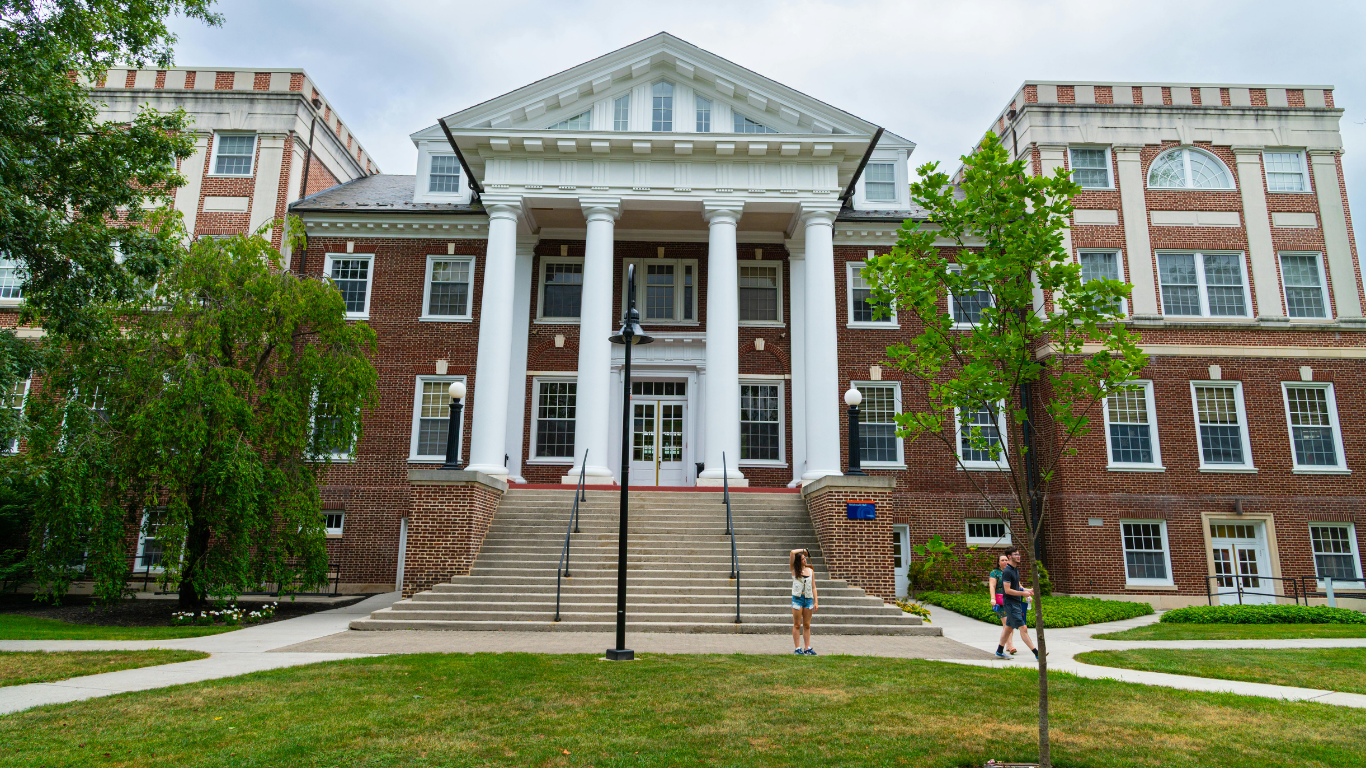Walking through the quiet campus of Bacone College today feels like stepping into a ghost town from another era. The old brick buildings, once alive with the chatter of students and the scent of fresh paint from art studios, now stand silent under a blanket of dust and overgrown weeds. Vines creep up the walls of McCoy Hall, and the Memorial Chapel’s bell hasn’t rung in months. This isn’t just any college shutting its doors- it’s Bacone, Oklahoma’s oldest higher education spot, founded way back in 1880 to give Native American kids a shot at learning. But after 145 years, Bacone College’s financial collapse has sealed its fate, leaving behind a trail of broken dreams, unpaid bills, and a community mourning the loss of a cultural lifeline.
It’s hard to believe how far this place has fallen. Bacone started as Indian University, born out of a generous land gift from the Muscogee (Creek) Nation to the American Baptist Home Mission Society. Back then, during the tough days of Indian Removal, it was a bold idea: to educate Native youth in a Christian setting while honoring their roots. Almon C. Bacone, a missionary with a vision, wanted to blend faith, culture, and knowledge. Over the decades, it grew into a haven for Indigenous students from tribes across the country- Cherokee, Choctaw, Seminole, you name it. By the mid-20th century, Bacone was pumping out teachers, nurses, and artists who went on to shape their communities. It wasn’t perfect; early years focused on assimilation, which some saw as erasing traditions. But by the 1930s, things shifted. The college became a cradle for Native American art, birthing the famous “Bacone style”- vibrant colors, flat perspectives, and stories of everyday tribal life painted with pride.
Picture this: In the 1940s, students like Woody Crumbo and Acee Blue Eagle turned heads in galleries, their works capturing the spirit of the Plains and Southwest without apology. Bacone’s campus held treasures- murals, sculptures, and artifacts that whispered histories of resilience. It wasn’t just school; it was a place where first-generation college kids from rural reservations found their voice. Enrollment peaked around 900 in 2017, with over 70% Native American students getting a mix of liberal arts, nursing, and business degrees in a supportive, faith-based bubble. Amanda Swope, director of tribal policy in Tulsa, calls it “a mecca in Indian Country.” For many, Bacone was the bridge from hardship to hope.
But glory days fade, and Bacone’s troubles started creeping in around 2010. Enrollment began dipping, down to 500 by 2015, then a nosedive to 106 by fall 2023. Why? Bigger state schools like the University of Oklahoma offered cheaper options, and online classes from anywhere stole the show. Rural Oklahoma’s economy wasn’t booming; families struggled with poverty rates twice the national average in Native communities. Bacone leaned hard on federal aid- Pell Grants, Title III funds for minority-serving schools- but it wasn’t enough. Tuition covered the basics, but donations dried up as alumni networks stretched thin.
Then came the mismanagement hits. Leadership turned over like clockwork – six presidents in eight years by 2020. Each promised fixes but left bigger messes. In 2018, then-president Frank Willis dropped a bomb: “We’ve run out of money.” Classes halted, staff got pink slips, and the campus went dark for months. It reopened, but scars lingered. Buildings fell apart- leaky roofs, busted HVAC, moldy walls. Art collections gathered dust because there was no cash for upkeep. Lawsuits piled up like storm clouds. Sodexo, the food service folks, sued for $1.1 million over a half-built dining hall in 2020. They settled, but the damage was done. Then Midgley-Huber Energy Concepts hit hard in 2023, claiming over $1 million for unapproved HVAC work that a prior admin greenlit verbally. The judge sided with them, slapping Bacone with a bill that nearly triggered a sheriff’s auction of the whole 200-acre campus in December 2023.
That auction got yanked at the last minute when the main creditor backed out, shocked by the web of other debts. But relief was short-lived. Embezzlement whispers turned to shouts. A 2024 Associated Press piece laid it bare: administrators accused of siphoning funds, accreditation hanging by a thread, and Native artworks rotting in basements. The Higher Learning Commission yanked accreditation in July 2024, killing federal aid eligibility. Without that, who could afford $20,000-a-year tuition? Spring 2024 classes? Suspended. Fall? A skeleton crew of 100 students limped through before the plug got pulled.
Enter Dr. Leslie Hannah, who stepped in as acting president in April 2024. He inherited a nightmare: $2 million in vendor debts, crumbling infrastructure, and a board in disarray. Hannah, a local with deep ties to Muskogee, saw potential. “Bacone’s not dead,” he told reporters in August 2024, even as break-ins and vandalism hit the empty campus- windows smashed, offices trashed. He hustled odd jobs, like food delivery, to cover payroll for the handful of staff holding the fort. Dreams of hybrid classes by fall 2025 danced in his head, maybe partnering with a bigger school to absorb credits and share costs.
But hope crashed into reality on June 25, 2024. Bacone filed for Chapter 11 bankruptcy – a reorganization lifeline to pause debts and plot a comeback. It bought time, but creditors circled like vultures. MHEC pushed to switch to Chapter 7 – straight liquidation, assets sold off, lights out for good. Hannah sold chunks of vacant land to chip at the debt, raising some cash but not enough. He eyed tribal college status from the Bureau of Indian Education, applied since 2019, but got denied in 2022 for murky reasons – maybe not “tribally controlled” enough, since Baptists still loomed large.
The hammer fell in May 2025. U.S. Trustee Ilene Lashinsky, overseeing the case, filed a scorching report: “gross mismanagement.” She zeroed in on a $16,500 payment from college funds to the Small Business Administration – for Hannah’s personal SBA loan, taken to cover payroll pre-bankruptcy. Neither Hannah nor the SBA was listed as a creditor. “This case is stagnant,” Lashinsky wrote. “The only hope is selling real estate.” Board member Josh Johns got dragged in, too, for not stopping it. A federal judge agreed on May 20, 2025: Convert to Chapter 7. Liquidate everything.
By May 22, Hannah handed over keys at 11 a.m. sharp, as ordered. “I can’t talk much – court gag order,” he muttered to KTUL cameras, eyes weary. The campus, that sacred 200 acres donated by the Creek Nation, now belongs to a court-appointed trustee. Auction whispers swirl: Maybe a developer scoops it for condos, or another college grabs it cheap. Priceless Native art? Packed in crates, fate unknown – museums? Storage? Sold to the highest bidder? Nine grads walked in May 2024, their diplomas bittersweet tokens of a dying era.
The human toll hits hardest. Take Sarah Yellowhawk, a fictional stand-in for the real stories pouring out. She’s Oglala Lakota, drove four hours from South Dakota for Bacone’s nursing program – affordable, culturally attuned, close to her Baptist faith. “It felt like home,” she’d say. But mid-degree, classes stopped. Transferred to Tulsa Community College, credits lost in the shuffle, extra years, and debt piled on. “Bacone was my anchor. Now? I’m adrift.” Faculty like Dr. Eliza Tsosie, who taught Indigenous literature for 15 years, packed her office in tears. “We molded minds here, preserved stories. Who’s doing that now for kids like mine?” Unemployment lines await; Muskogee’s job market is slim for PhDs.
The Native community feels gutted. Bacone wasn’t just classes; it was powwows, language revivals, art that screamed identity. Losing it widens gaps-fewer spots for rural Indigenous youth chasing degrees. Tribal leaders from the Muscogee Nation vow to fight for the land’s return, maybe as a cultural center. “It’s our history they’re auctioning,” says one elder on X. Swope echoes: “A mecca gone. Rural Oklahoma loses big- higher ed options shrink, especially for Natives.” Economically? Muskogee bleeds. The college invested $5 million annually in local shops, diners, and motels. Now, empty dorms mean empty cash registers.
Zoom out, and Bacone’s story mirrors a higher ed crisis. Over 100 small colleges have shuttered since 2016, primarily due to enrollment declines, the pandemic, and aid cuts. Minority-serving schools like Bacone get hit hardest; they serve low-income kids but lack endowments to weather storms. Lessons? Diversify revenue – online programs, corporate ties, alumni drives. Watch debts like hawks; transparency builds trust. And leadership? Steady hands, not revolving doors. For Native institutions, federal boosts like expanded Title III could stem the bleed.
As September winds down, the trustee’s gavel looms. On X, alumni rally: “Save Bacone’s soul – buy the art, not the bricks.” Petitions swirl for a tribal buyback. Hannah? Still optimistic in whispers, plotting a phoenix rise elsewhere. But for now, the campus sleeps. Bacone’s collapse isn’t just numbers – it’s erased laughter, unfinished canvases, futures rerouted. In Muskogee’s humid air, you can almost hear the echoes: A reminder that even legends need more than heritage to survive.
What comes next? Watch the auctions; they might decide if Native stories get new walls or fade to footnotes. Until then, Bacone teaches us: Fight for your roots, but defend them fiercely.




